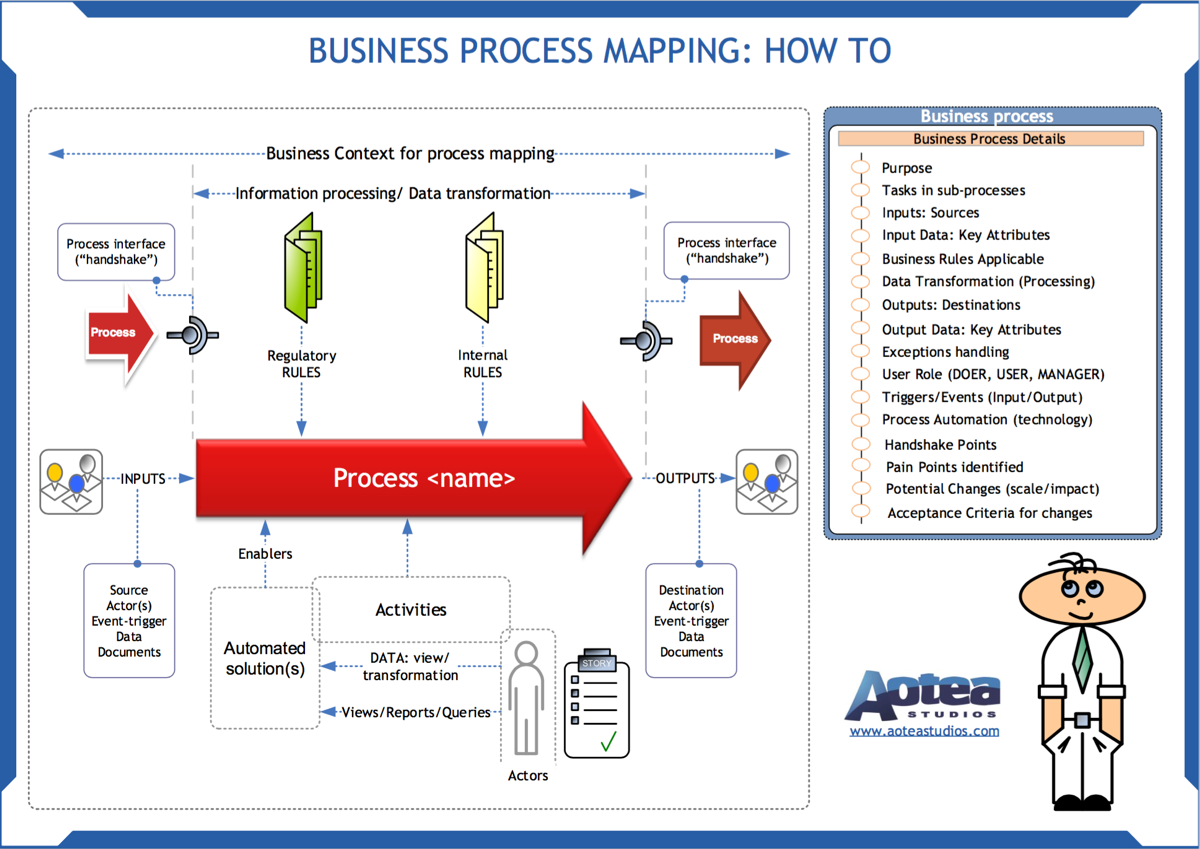5 Steps to Improve Your Process Mapping Skills
Process mapping is one of the basic business analysis tools. The technique has acquired more importance in recent times as complexity of processes continues to grow. The technique enables you to capture and visualise knowledge that resides with the people who perform daily business tasks. There are some challenges in getting the mapping right.
You must follow some basic rules to produce good process maps that make them easier to understand and use. I would like to share with you my practical insights into the process mapping exercise.
I like to think that process mapping is akin to walking into a poorly lit room. At first, you recognise just bulky objects. But after a while smaller items start to reveal their contours and fill in the space around you.
Let’s imagine that you’ve already got your process mapping session scheduled with stakeholders. Questions might revolve in your head, “How do I get it right on the first go? What should I do to avoid pitfalls?”
I would like to share my experience and outline the key factors for success in creating process maps. Let’s explore the elements of process mapping in a bit more detail and also focus on how you can prepare yourself.
##What is the value of this technique?
From my experience, process mapping generates a great insight into a normal business day. It reveals all these “boring” tasks that employees routinely perform. It shows relationships with other processes and introduces you to new actors and their tasks.
A key outcome is that you walk away with a good understanding of the current state and it keeps you from getting requirements wrong.
A good process map helps you in several ways:
- Capture process details
- Visualise data flows
- Identify bottlenecks
- Prevent delays and waste of time
- Minimise redundant rework.
The completed process map serves you as a solid basis for developing a solution.
1. What should I focus on?
Process mapping is about identifying all process attributes:
- Triggering events(s) of the process in focus
- Input information and documents
- Tasks within the process in question
- Transformation of inputs into outputs
- Decisions made to support transformation of inputs into outputs
- Relationships and inter-dependencies with other processes
- Who performs the process and its tasks
- What enabling technology is available
- Trigger(s) to release the process output.
2. How do I prepare for process mapping?
You need to know the following before you start mapping:
- Who DOES the work
- Who provides INPUTS
- Who receives OUTPUTS
- Who MANAGES the process
- What TECHNOLOGY solutions are in the use.
3. What questions should I ask?
There are quite a few questions you need to have ready:
- If there is a pain point, why are we still doing that task?
- What is the impact of not doing this task?
- What change could reduce or cut the pain point?
- If the task/process changes, what are new conditions for doing the job:
- steps
- governing business rules
- enabling technology
- training (new skills)
- What are acceptance criteria for the changes?
TIP: Don’t be afraid to ask about “obvious” things that your DOER just takes for granted. Keep your ears open to what is said to you. Use these clues to pose more questions.
4. What are the key outputs of process mapping?
After drafting and examining the mapped process, you can specify the following:
- Business context
- Current state of the process
- Involved DOERs
- Key pain points (rework, delays, waste etc)
- All tasks within the process
- Process interfaces/exchange points
- Impact of pain points
- Potential changes helping to cure the pain points
- Change acceptance criteria.
5. Why should I care about interfaces?
The interfaces between the processes are important for the design of the solution. Try to capture
- Handshake points
- Who owns the process/tasks before and after the handshake point.
Some process outputs can cross an organisation’s boundary. In this case you also need to know when a response to that output will be received back to enable the process to complete. Timing is an important attribute to capture!
Extra tips for using the technique
It is important to engage the identified DOERs in the process mapping exercise. Only the people doing the process tasks can give you information that you are after.
When you collaborate with your DOERs, “sell” the purpose of the exercise – make their job smarter instead of keeping it hard.
Don’t be afraid to ask about “obvious” things that your DOER just takes for granted.
Keep your eye on the most painful aspects of the mentioned tasks, make notes about possible causes of the pain points.
Don’t map everything mentioned by the DOERs. Only map the process that you’ve chosen to map.
What’s next?
Apply the steps and tips above to your next process mapping exercise. Practise asking questions and keeping your scope tight. Use the handy tool I’ve added below:
Until next time!

New! We have published a new book: A Navigator to Business Analysis.
Over 400 pages of practical, useful material will help you build your skills and advance your career! Find out more and get free excerpt.
Free course: BABOK 3 Navigation Maps
Subscribe and get an overview of the knowledge areas in BABOK 3. (Very occasionally, we may let you know about discounts and specials).
